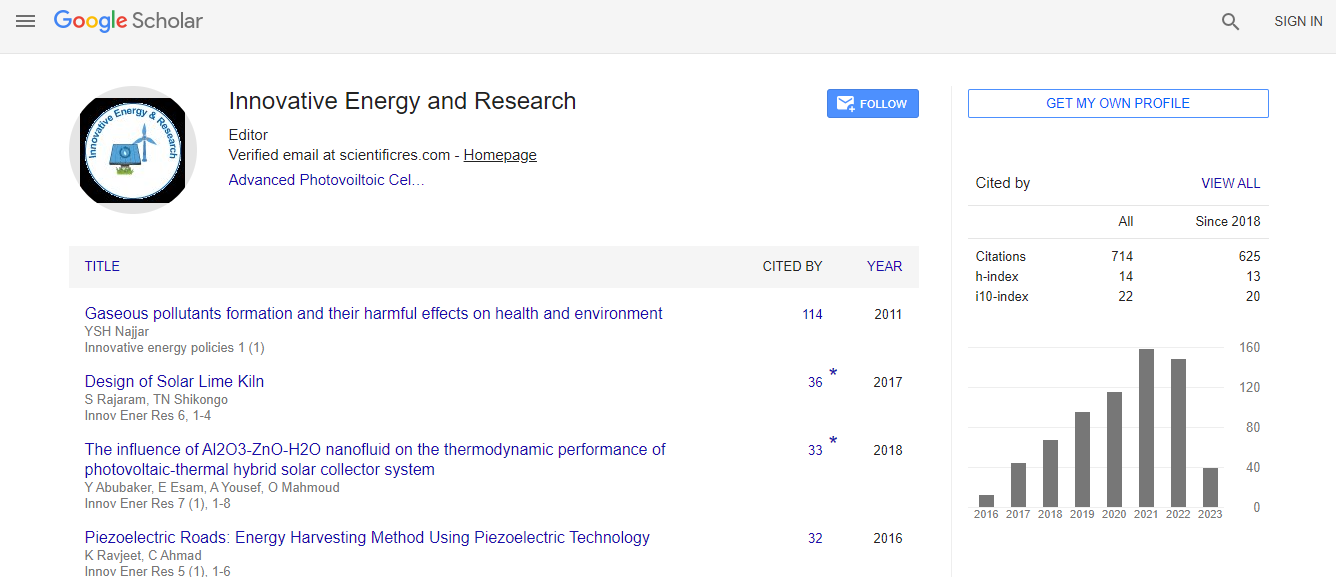Our Group organises 3000+ Global Conferenceseries Events every year across USA, Europe & Asia with support from 1000 more scientific Societies and Publishes 700+ Open Access Journals which contains over 50000 eminent personalities, reputed scientists as editorial board members.
Open Access Journals gaining more Readers and Citations
700 Journals and 15,000,000 Readers Each Journal is getting 25,000+ Readers
Google Scholar citation report
Citations : 712
Innovative Energy & Research received 712 citations as per Google Scholar report
Innovative Energy & Research peer review process verified at publons
Indexed In
- Google Scholar
- Open J Gate
- Genamics JournalSeek
- RefSeek
- Hamdard University
- EBSCO A-Z
- Publons
- Euro Pub
- ICMJE
Useful Links
Recommended Journals
Related Subjects
Share This Page
Synthesis of vertical graphene network as platform for electrochemical applications
21st International Conference on Advanced Energy Materials and Research
Mineo Hiramatsu
Meijo University, Japan
ScientificTracks Abstracts: Innov Ener Res
Abstract
Graphene based materials such as carbon nanotube and graphene sheet itself have a wide range of possible applications. Among these grapheme based materials, carbon nanowalls (CNWs) are self- supported network of few-layer graphenes standing almost vertically on the substrate to form 3-dimensional structure. The mazelike architecture of CNWs with large-surface area graphene planes would be useful as electrodes for energy storage devices, electrochemical and biosensors and scaffold for cell culturing. CNWs and related materials can be synthesized by several plasma enhanced chemical vapor deposition (PECVD) techniques on heated substrates employing CH4 and H2 mixtures. Control of CNW structures including spacing between adjacent nanowalls and crystallinity is significant for the practical applications. Moreover, surface functionalization including surface termination and decoration with catalytic metal nanoparticles should be established. We report the current status of fabrication and structure control of CNWs using several PECVD techniques. Moreover, CNW surface was decorated with Pt nanoparticles by the reduction of chloroplatinic acid or by the metal-organic chemical deposition employing supercritical fluid. We also report the performances of hydrogen peroxide (H2O2) sensor and fuel cell, where CNW electrode was used. For the H2O2 sensing application, CNWs were grown on carbon fiber paper (CFP) using PECVD with CH4/Ar mixture to increase the surface area. Then, CNW surface was decorated with Pt nanoparticles by the reduction of H2PtCl6 in solution. Cyclic voltammetry results showed that the Pt-decorated CNWs/CFP electrode exhibited excellent electrocatalytic activity to the reduction of H2O2. Similar structure was also used as a catalytic layer of the polymer electrolyte fuel cell. From the electrochemical investigation, Pt-decorated CNWs showed excellent electrochemical durability compared with the carbon black. Electrochemical experiments demonstrate that platform based on vertical nanographene offers great promise for providing a new class of nanostructured electrodes for electrochemical sensing and energy conversion applications.Recent Publications
1. Imai S, Kondo H, Hyungjun C, Ishikawa K, Tsutsumi T, Sekine M, Hiramatsu M and Hori M (2019) Pt nanoparticle-supported carbon nanowalls electrode with improved durability for fuel cell applications using C2F6/H2 plasma-enhanced chemical vapor deposition. Applied Physics Express 12:015001.
2. Tomatsu M, Hiramatsu M, Foord J S, Kondo H, Ishikawa K, Sekine, M Takeda K and Hori M (2016) Hydrogen peroxide sensor based on carbon nanowalls grown by plasma-enhanced chemical vapor deposition. Japanese Journal of Applied Physics 56:06HF03.
3. Watanabe H, Kondo H, Okamoto Y, Hiramatsu M, Sekine M, Baba Y and Hori M (2014) Carbon nano wall scaffold to control culturing of cervical cancer cells. Applied Physics Letters 105:244105.
4. Hiramatsu M and Hori M (2010) Carbon nanowalls: synthesis and emerging applications. Springer Verlag Wien.
5. Hiramatsu M, Shiji K, Amano H and Hori M (2004) Fabrication of vertically aligned carbon nanowalls using capacitively coupled plasma-enhanced CVD assisted by hydrogen radical injection. Applied Physics Letters 84:4708-4710
Biography
Mineo Hiramatsu is a Full Professor of Department of Electrical and Electronic Engineering and the Director of Research Institute, Meijo University, Japan. He served as the Director of The Japan Society of Applied Physics. His main fields of research are plasma diagnostics and plasma processing for the synthesis of thin films and nanostructured materials. He served as Chairman and Member of organizing and scientific committees of international conferences on plasma chemistry and plasma processing. He was awarded the Japan Society of Applied Physics Fellow in 2017.
E-mail: mnhrmt@meijo-u.ac.jp

 Spanish
Spanish  Chinese
Chinese  Russian
Russian  German
German  French
French  Japanese
Japanese  Portuguese
Portuguese  Hindi
Hindi 
